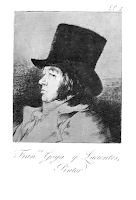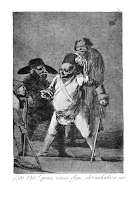Likerty
 Caprichos is a set of 80 aquatint prints created by the Spanish artist Francisco Goya during the 1790s.
Caprichos is a set of 80 aquatint prints created by the Spanish artist Francisco Goya during the 1790s.The prints were Goya's artistic experiment: a medium for his condemnation of the universal follies and foolishness in the Spanish society in which he lived. The criticisms are far-ranging and acidic; he speaks against the predominance of superstition, the ignorance and inabilities of the various members of the ruling class, pedagogical short-comings, marital mistakes, and the decline of rationality - among other things. Goya described the series as depicting "the innumerable foibles and follies to be found in any civilized society, and from the common prejudices and deceitful practices which custom, ignorance, or self-interest have made usual".
The work was an enlightened, visual tour-de-force critique of 18th century Spain, and humanity in general. The informal style, as well as the depiction of contemporary society found in Caprichos, makes them – and Goya himself – a precursor to the modernist movement almost a century later.
Caprichos were withdrawn from public sale very shortly after their release in 1799. Only a formal order from King Carlos IV kept Goya from being called before the Spanish Inquisition.
Goya added brief explanations of each image to a manuscript now in the Prado; these help greatly to explain his often cryptic intentions, as do the titles printed below each image.
The Sleep of Reason produces Monsters (below) in particular has attained an iconic status.

All pictures: HERE






















































































